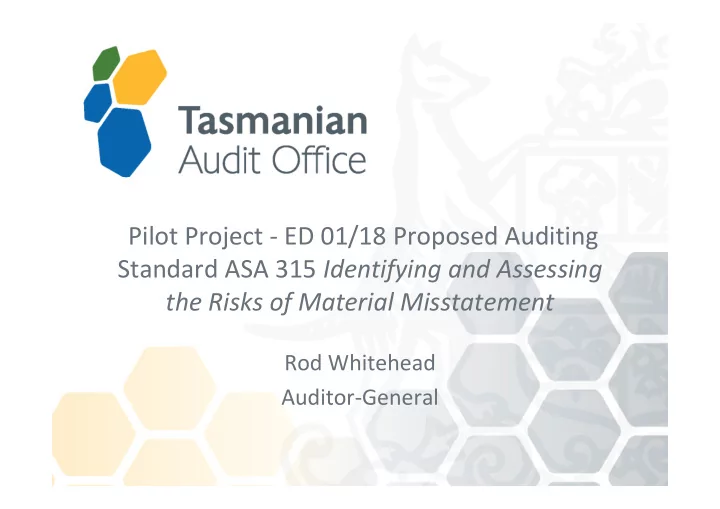

Pilot Project - ED 01/18 Proposed Auditing Standard ASA 315 Identifying and Assessing the Risks of Material Misstatement Rod Whitehead Auditor-General
Outline • Proposed auditing standard ASA 315 future changes • ASA 315 pilot project objectives • Pilot participants • Materiality • Risks of material misstatement • Controls to mitigate the risks 97
Proposed ASA 315 future changes • Exposure draft released August 2018 • Proposed to be operative for financial reporting periods commencing on or after 15 December 2020 • Improved understanding of the risk identification process • Promote a more robust process for the identification and assessments of the risks of material misstatements • Revised definition of “significant risk” • Enhanced and clarified identification of relevant controls • Paragraphs 29 – 31 – auditor evaluation of identified risks and risk assessment process 98
ASA 315 pilot project objectives • Objective - to understand entities’ assessment of: – what is material in the context of the financial report – risks that could result in material misstatements the financial report – controls relied upon to address those risks • Expected outcomes: – comparison of views around the determination of materiality – ‘gaps’ in the identification of risks relevant to financial reporting – potential deficiencies in entity risk assessment processes 99
Pilot participants Invited 28 participants: • 10 councils No • 8 departments response, 9, • 10 businesses 32% Response received, 16, Declined to 57% participate, 2, 7% No matters to advise, 1, 4% 100
101
Materiality No quantitative value, 3, 19% Same as TAO materiality, 8, 50% Lower than TAO materiality, 5, 31% 102
Materiality • Should materiality be quantified? “Materiality assessed on both the nature and/or magnitude of information that could misstate or obscure information” • Should different materiality amounts be used? “We look at each financial item and determine what we think is an appropriate materiality given its size and nature and resulting impact on the financial statements. Therefore we don't have just one dollar amount we use to determine materiality as it will be different for every type of financial item.” 103
Materiality • Should materiality be based on prior year information or using current year budget or forecast information? ‘Materiality 1% of 2017-18 actual expenditure adjusted for activities transferred as part of machinery of government changes’ • Are other non-financial reporting indicators appropriate for assessing misstatements in the financial statements? ‘Materiality based on the amount used for Major Risk in the risk management policy rating table’ • Does your entity have a stated position on assessing the impact of misstatements in the financial report? 104
105
Risks of material misstatement 16 Number of significant (high) risks 14 12 10 8 6 4 2 0 Client risks TAO risks 106
Risks of material misstatement Significant risks: • possibility of, or exposure to, fraud • recent significant economic, accounting or other developments • complex transactions • significant transactions with related parties • subjectivity in the measurement of financial information related to the risk, e.g. valuations • significant transactions that are outside the normal course of business for the entity, or appear to be unusual • risks arising from IT 107
Risks of material misstatement Routine, non-complex transactions that are subject to systematic processing are less likely to give rise to significant risks. Possibly not significant risks: • risks relating to miscoding of transactions, incorrect recognition of transactions in correct financial year, incomplete transactions • cash and cash equivalents (unless fraud risks are evident) • ‘Accuracy of financial reporting’ 108
109
Controls 110
Controls – ‘good’ • Segregation of duties • Delegations • Periodic reconciliations • Review and approval of journals • Management review • Critical accounting estimates and judgements are reviewed and approved by Managers, Audit Committee, TCWG • Reliance on internal audit • Reliance on experts 111
Controls – ‘better’ • System access controls and role security controls that govern access to (electronic) information • System managed delegations • Dual authorisation controls • Staff training and acknowledgements/representations • Calls to vendors to confirm vendor bank account changes • Bank files uploaded by person with no access to financial system • IT service continuity and incident management processes are in place and tested regularly • Dedicated cybersecurity team established 112
Controls – ‘hmm…’ • Descriptions of processes rather than controls • Controls are not clearly defined, e.g. ‘monitoring of transactions’, ‘monitoring of Standards for compliance’, ‘financial statements are reviewed and approved’ • Controls do not appear to mitigate the risk, e.g. ‘revaluations and annual escalations are designed to provide an asset valuation that is as accurate as possible’ • Very high level of reliance on management review – any assurance this is happening? • Reliance on experts – is the work of the expert assessed? • Reliance on the TAO – beyond the three lines of defense! 113
Recommend
More recommend